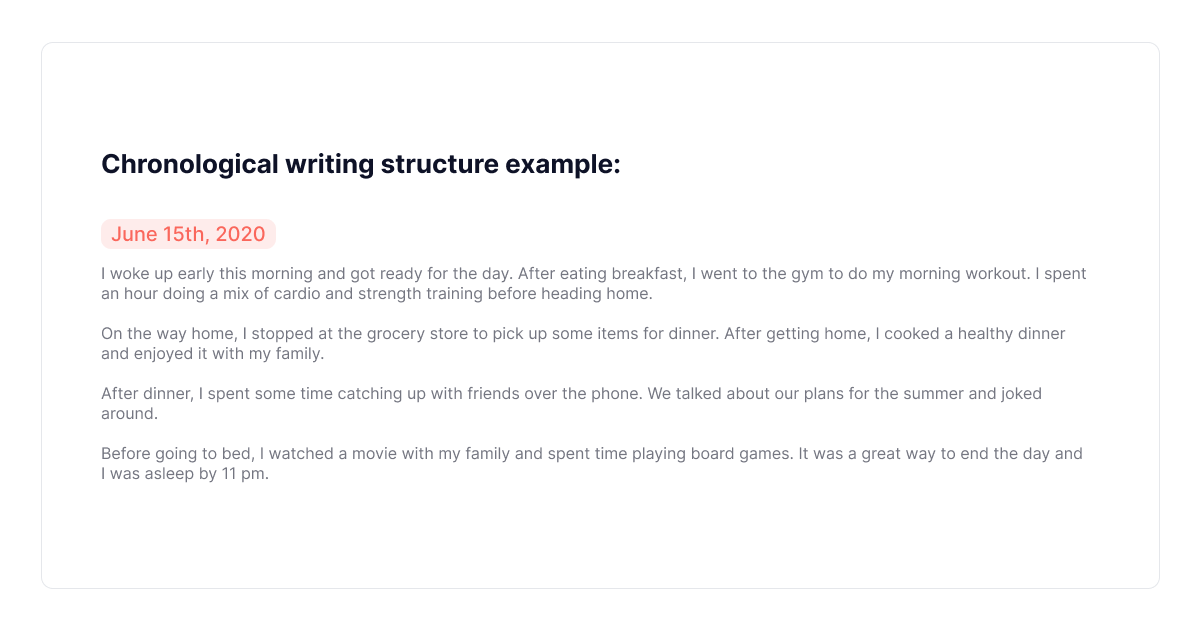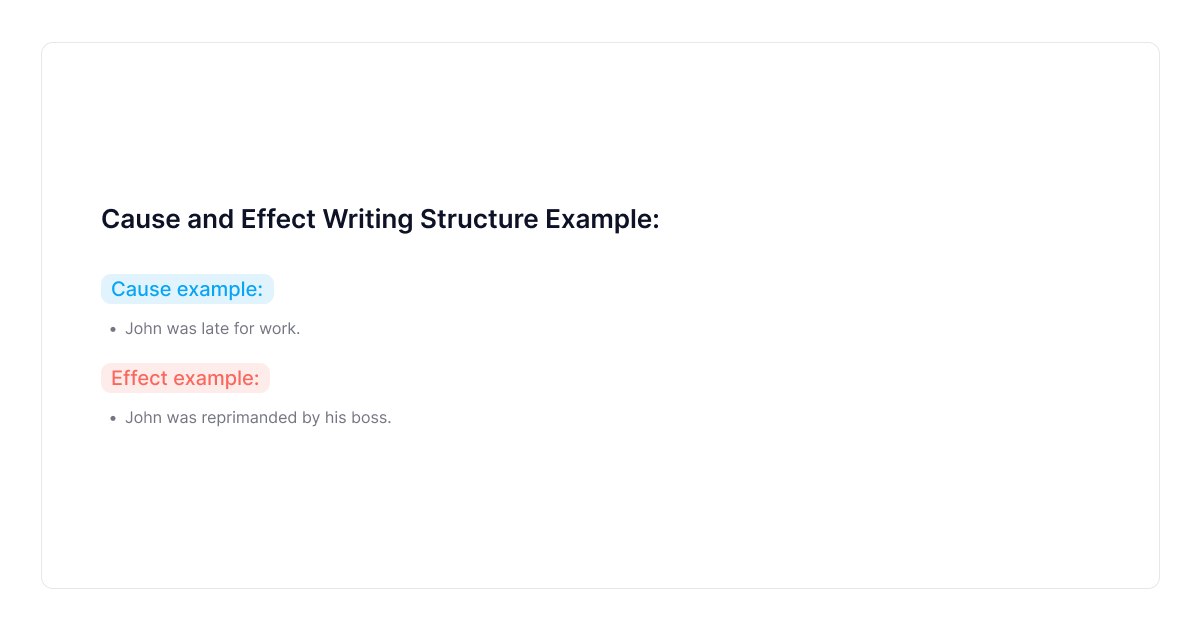You may have wondered, "What are the basic writing structures, and when and how should I use them?"
You probably use a variety of writing structures without giving them much thought.
Each structure, however, has a place and a function, and when used correctly, it can help you get the most from your writing.
Fortunately, the most significant advantage of different types of structure in writing is that you can combine them despite differences in the content type.
Read on to learn about the modern era's most widely used writing structures.
Alright, let's get started!
What Is A Basic Structure Of Writing?
The standard three-part writing structure comprises an introduction, a main body, and a conclusion.
As a rule, a topic summary and thesis statement are part of the introduction.
The paragraphs in the body of the essay provide the reasoning, analysis, and proof needed to back up the thesis.
In the final section of content, the author makes a closing argument or observation.
How Many Writing Structures Are There?
There is no universal solution to this question since there are so many different ways to structure writing.
The five-paragraph essay, the narrative structure, the argumentative structure, the compare and contrast structure, the descriptive structure, etc., are all common writing structures.
Today, we'll cover the 8 most common types of structure in writing.
Let's check them out.
The 8 Most Common Types of Structure in Writing
1. Chronological Writing Structure
A chronological (time-based) writing structure, such as the one used in the example below, is highly effective when you need to tell a story or recount events in order.
It is an appropriate writing style in stories, biographies, and historical accounts.

You can use a time-based structure to trace an individual's or an event's development.
It is an excellent strategy for maintaining readers' attention and stoking curiosity.
2. Logical Writing Structure
A logical writing format is employed to arrange data per the validity of various claims.
It is a typical writing style in academic writing, including essays, research papers, and theses.
For example, the standard five-paragraph essay format illustrates a well-thought-out, rational approach to writing.
You can start an introductory paragraph with a thesis statement, three body paragraphs with evidence to back up the thesis, and a conclusion paragraph that recaps the essay's main points.

With the analytical framework, your arguments will be more convincing and easy to follow for the reader.
It also helps with keeping track of ideas and keeping your thoughts in order.
Remember, though, that there is no "correct" way to organize an essay or research paper.
Instead, finding out what works best for you and your topic through trial and error is the best way to choose a format.
3. Argumentative Writing Structure
We often use an argumentative writing structure to present an argument in a clear and convincing way.
It is the most common writing format we can often see in essays, research papers, and other types of academic writing.
The claim, the evidence, and the counterargument make up the trifecta of a compelling argument.

The claim is the most crucial part of the argument that needs to be backed up.
The evidence can be either direct or indirect, but it must be convincing enough to support the claim.
Finally, it's necessary to address the counterargument prepared in response to debunk the other side's argument.
4. Comparison and Contrast Writing Structure
This format is often used when drawing parallels between multiple entities.
It is a common technique in many forms of writing, including essays, reviews, and articles.
Writing a comparative essay can be approached from several angles.
The most common method is a point-by-point comparison, in which each feature of one thing is matched up with its counterpart in the other.

For example, you could look at two cars side by side and evaluate their relative merits.
In a block structure, you discuss each component of one thing before discussing each element of the other.
As an illustration, you could go over every aspect of one vehicle before moving on to the other.
5. Problem and Solution Writing Structure
Using PAS structure, you can present an issue and its potential resolutions in your writing in an engaging and effective manner.
What’s more, a problem-solving writing method is vital for organizing one's thoughts and ideas.
Hence, this organizational framework is known as the "problem and solution" writing model.
First, you must ascertain the nature of the issue at hand. After that, you consider all the angles and devise a plan B.
Ultimately, you decide on the best action plan and put it into effect.

Writing in a problem-and-solution format can help you hit on your readers' sore spots.
6. Cause and Effect Writing Structure
Cause and effective writing structure focus on the chain of causation that links one idea or event to another. We use it to explain why something happened or what happened.
To effectively utilize this format in your writing, you should be familiar with the concept of cause and effect.

You can begin writing your essay once you have a firm grasp of the topic's background context and subsequent outcomes.
After you have completed this step, you will be able to put your thoughts in a coherent order and begin drafting your essay.
Introduce yourself and the subject you'll be covering.
Then, get straight to the meat of the matter - provide evidence and examples to back up your claims.
7. Classification Writing Structure
The classification writing structure helps you efficiently organize the information in your writing.
For example, you can organize your information by putting them into categories.
Let's say, for example, that you are writing a book review article. You can separate these books by genre, author, subject, and many others.

This writing structure can help you organize your thoughts and make this review much more digestible for your readers - they can quickly find the relevant information they are looking for.
Libraries and product catalogs are examples of the many contexts in which you can use classification writing structures.
8. Spatial Writing Structure
When you use a spatial writing structure, we can arrange our information according to physical location or area.
This method can be helpful when writing a descriptive piece, especially about a location you have visited or would like to visit.
Additionally, it's a fantastic way to make your points more understandable to readers.

If you're having trouble starting, consider coming up with a list of important locations.
That might be the house you grew up in, a place you like to go on vacation, or even just a location you pass by every day.
Consider how you describe each location once you have a few in mind:
- What specifics would you provide?
- What feelings do they arouse?
By structuring your essay around these details, you can produce a vivid and engaging piece of writing.
Final Thoughts
I have a hunch that you've been using at least three of the 8 most common types of structure in writing without even realizing it.
While their use can improve the overall quality of your content, that won't be enough to keep readers coming back just because you added them.
Since it's impossible to absorb all the advice on engaging writing published online, we've developed an excellent add-on called TextCortex.
Not only can immediately elevate the standard of your writing, but it can also AI generate high-quality content of any type on the go.
What is TextCortex?
TextCortex add-on is a use-case module-based writing assistant tool that can help you write and rewrite content on more than 30+ most popular online platforms.
You can edit your content directly in Google Docs, the Hemingway app, Notion, Facebook, Instagram, LinkedIn, Gmail, and many others.
By leveraging advanced technology, TextCortex can provide its users with a wide range of beneficial tools that allow you to:
- Rewrite the piece for a more valuable connotation.
- Expand existing paragraphs with new information.
- Reduce lengthy passages to their essential details.
- Modify the vocal pitch of your paragraphs to convey the intended meaning.
- Create complete, coherent paragraphs and sentences from fragmented ideas.
- Provide accurate translations of your text into a dozen languages, such as German, Romanian, French, Portuguese, and more.
- Text-to-speech to read your content aloud.
Although these features are known and helpful, TextCortex adds new rewriting functionality that makes this tool stand out beyond its competition.
🎖️The "Long-form post" feature can expand a five-word idea into a 300-word article with a single strike.
🎖️Quickly and easily convert your bullet points into formatted email body text with the "Bullet to Email" function.
What’s more, the TextCortex add-on features more than 60 available AI templates for any content form you need. They are separated into the following categories:
- General — Rewriting, tone, summarizing, answer to the question, etc.
- Email — Email replies, cold emails, general emails, and subject lines.
- Ads and marketing tools — Advertisement copies for various platforms.
- Social media — social media content for Facebook, Instagram, LinkedIn.
- Website copy — AI-generated landing page and website copy.
- eCommerce — Titles and descriptions for e-commerce.
How Does TextCortex Add-On Work?
To leverage TextCortex features, all you need to do is to highlight the text that needs modification and choose the feature from the rewriting menu.
To access AI templates, click on the purple bubble and choose the form you need for your content.
Tempting?
Claim your TextCortex free account to receive 10 free daily creations and test the wide waters of content creation.
Keep Learning
What Are Writing Styles & How To Apply Them In Your Writing
How To Improve Readability Of Your Content & Why That Matters
7 Easy Steps To Rewrite A Sentence Without Changing The Meaning


.jpg)

